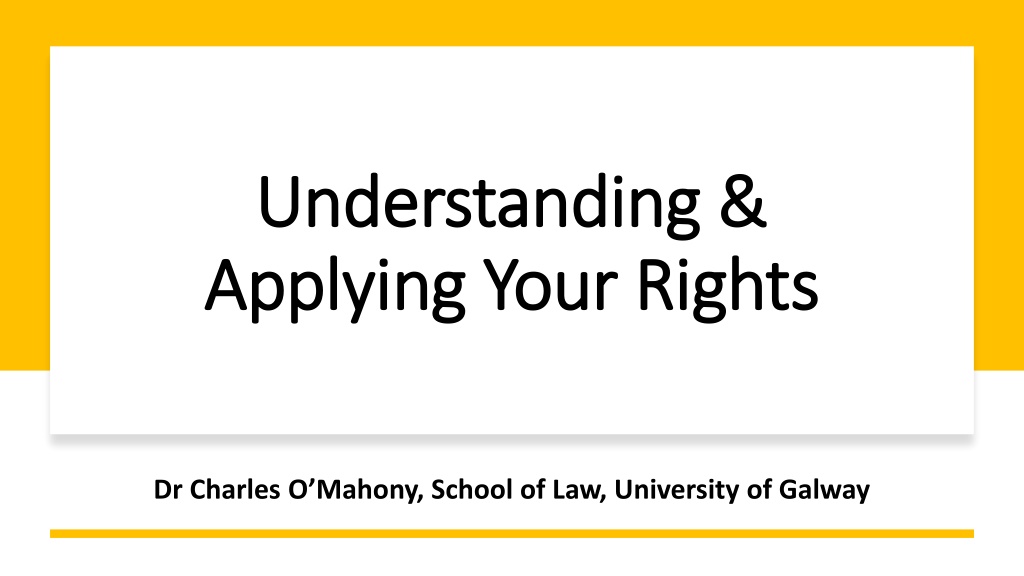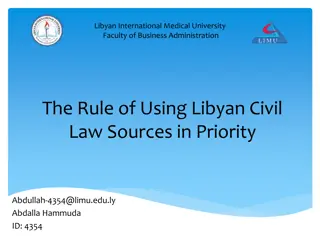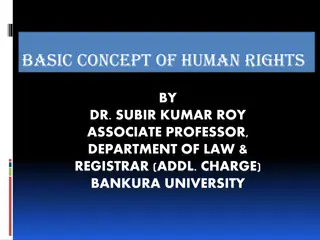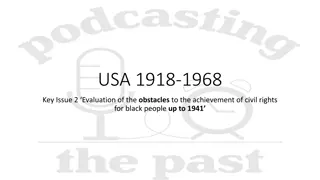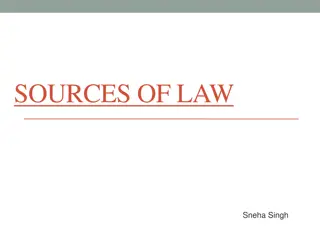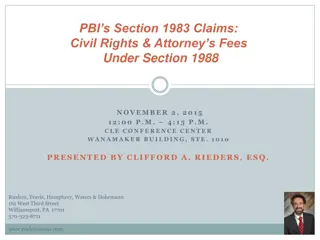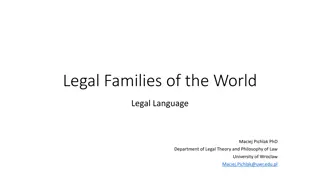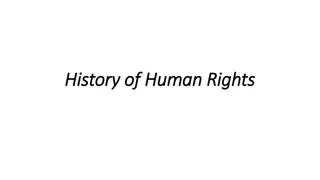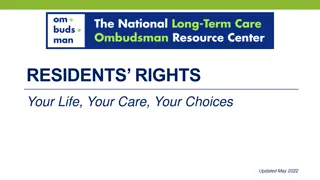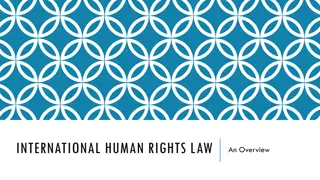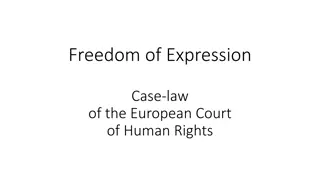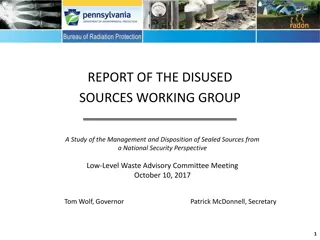Applying Your Rights: Sources and Understanding Law
Here you will find valuable insights on the sources of law, including the Constitution, Case Law, Legislation, and more. Explore the concept of equal rights, reasonable accommodation, and discrimination through a legal lens. Delve into the intricate framework of legal systems and understand how rules interact within legal structures. Gain knowledge on international law and access to justice, with case studies for a comprehensive overview.
Download Presentation

Please find below an Image/Link to download the presentation.
The content on the website is provided AS IS for your information and personal use only. It may not be sold, licensed, or shared on other websites without obtaining consent from the author. Download presentation by click this link. If you encounter any issues during the download, it is possible that the publisher has removed the file from their server.
E N D
Presentation Transcript
Understanding & Understanding & Applying Your Rights Applying Your Rights Dr Charles O Mahony, School of Law, University of Galway
1. Sources of Law 2. UN Convention on the Rights of Persons with Disabilities 3. What is reasonable accommodation? 4. What is Discrimination? 5. The Equal Status Acts 6. Access to Justice 7. Case Studies Overview of Overview of Presentation Presentation
Sandra Fredman Sandra Fredman Instead of requiring disabled people to conform to existing norms, the aim is to develop a concept of equality which requires adaptation and change . See Fredman, Sandra, 'Disability Equality: A Challenge to the Existing Anti- Discrimination Paradigm?' in Disability and Equality Law (1st edn, Routledge 2005) 20
1. Sources of Law 1. Sources of Law
What do we mean by the term sources of law? What do we mean by the term sources of law? (1) (1) The term sources of law refer to the origins of legal of rules. We need to understand the origins of different rules and map out the relationship of the different rules to each other. We need to know where you can locate rules and apply those rules to legal problems. One of the difficult things is understanding precisely how the different rules slot into the overarching structure.
What do we mean by the term sources of law? What do we mean by the term sources of law? (2) (2) A particular difficulty is to understand how to resolve a legal problem when there appears to be conflict between legal rules. Therefore, in our legal system we categorise different sources of law within a hierarchical framework. As this is a hierarchical system, some sources of law will triumph over other sources of law, where the rules conflict. In Ireland there are 4 main sources of law within our legal system. We need to understand these sources of law and which sources will triumph over the other when there is a conflict.
Main sources of law Main sources of law In Ireland 1. The Constitution 2. Case Law / Common Law 3. Legislation 4. European Union Law Other Sources 1. International Law
Important Sources of Law for Persons with Important Sources of Law for Persons with Disabilities Disabilities United Nations - Convention on the Rights of Persons with Disabilities (CRPD) European Union European Convention of Human Rights European Social Charter (Revised) Ireland Legislation Case law
2. UN Convention on the 2. UN Convention on the Rights of Persons with Rights of Persons with Disabilities Disabilities
CRPD (1) CRPD (1) The CRPD was the first comprehensive human rights treaty of the 21st century and the first human rights convention that regional integration organisations (e.g. the European Union) could sign. The Convention officially came into force on the 3rdof May 2008, and had been driving a worldwide law reform programme since, with State Parties seeking to bring their domestic law into compliance. The CRPD represents the culmination of the disability rights movement which has challenged prejudicial and discriminatory perceptions of persons with disabilities. The CRPD provides clear instructions to State Parties on how different categories of rights relate to persons with disabilities. The rights contained in the CRPD are set out in Articles 9-30. The rights can be loosely categorised as follows: (i) rights that protect the person; (ii) rights that restore autonomy, choice and independence; (iii) rights of access and participation; (iv) liberty rights; and (v) economic, social and cultural rights.
CRPD (2) CRPD (2) Ireland has robust equality legislation and a significant legal framework to protect human rights Persons with disabilities are equal citizens in Irish law. Discrimination on the grounds of disability is prohibited under the Equality Acts. The areas covered by the Acts include employment, education and the provision of goods and services. Initial Report under the Convention on the Rights of Persons with Disabilities Ireland Committee on the Rights of Persons with Disabilities, 2021.
Towards Harmonisation of National Legislation with the United Nations Convention on the Rights of Persons with Disabilities There is a need to review the Employment Equality Acts and the Equal Status Acts with regard intersectional discrimination and how an individualised approach can be strengthened to assessment under the reasonable accommodation process. Consideration of funding under the Equal Status Act for those with limited resources and an amendment to provide that denial of reasonable accommodation is discriminatory is also necessary. Exemptions to the prohibition of discrimination in the Employment Equality Acts also need to be reviewed, particularly the removal of Section 35(1) on different rates of remuneration for disabled people . SeeJoint Committee on Disability Matters, Towards Harmonisation of National Legislation with the United Nations Convention on the Rights of Persons with Disabilities (January 2024) 33/DM/16. See pages 29-30
Ireland Ireland Employment Equality Acts 1998 2015 (Employment including vocational training) Equal Status Acts 2000 2018 (Provision of Goods and Services including Education) Both Acts amended to give effect to Framework Employment and Race Directives. Supreme Court in Nano Nagle v Daly [2019] IESC 63 Landmark decision on reasonable accommodation (employment case).
Why is this relevant? Why is this relevant? We cannot evade this legal obligation. There is a growing legal agreement at both national and regional levels, including within the European Union. The CRPD serves as the primary overarching legal framework that is shaping our perspective on what constitutes reasonable accommodation. Unfortunately, the Equal Status Acts are weak in protecting the rights of students.
3. What is reasonable 3. What is reasonable accommodation? accommodation?
What is reasonable accommodation? What is reasonable accommodation? Failure to provide reasonable accommodation is discrimination. Individualised duty (both parties) Two-part Test
4. What is 4. What is Discrimination Discrimination
Discrimination Discrimination CRPD Committee has stated that there is a duty to legislate to ensure that reasonable accommodation provisions are enshrined in law. These laws should ensure that reasonable accommodation is recognised and punishable form of discrimination (Concluding observations on the Initial Report on Germany 13 May 2015.) What about the EEA and the ESA? EEA ESA
5. Equal Status Acts 5. Equal Status Acts
Individualised Duty Individualised Duty Under the CRPD reasonable accommodation means necessary and appropriate modification , where needed in a particular case Under the EEA that employer is required to take appropriate measures, where needed in a particular case, to enable a person Under the ESA a service to do all that is reasonable to accommodate the needs of a person School Institute Name to go here
Two Parts to Reasonable Accommodation Two Parts to Reasonable Accommodation 1. 2. The first part is a positive legal duty The second part is consideration of a disproportionate or undue burden School Institute Name to go here
Duty to accommodate Duty to accommodate | | Part 1 Part 1 Triggered or enforceable from the moment a person with a disability requires an accommodation. Pre-emptive duty occasionally. Proposed accommodation must be reasonable i.e. address the actual barrier to inclusion. Process requires dialogue between the duty bearer and the person with a disability Caveat re dialogue Nano Nagle Supreme Court Judgment School Institute Name to go here
Duty to Accommodate Duty to Accommodate | | Part 2 Part 2 Limited by disproportionate or undue burden (single concept). Also individualised and reactive BUT Equal Status Acts Nominal Cost Factors to determine burden: cost, structural burden, disruption, and benefit. Perception of unfairness by others (ought not be a consideration). School Institute Name to go here
Equal Status Acts 2000 Equal Status Acts 2000- -2018 2018 Weak provision for a number of reasons: 1. discrimination if without such special treatment or facilities it would be impossible or unduly difficult for the person to avail himself or herself of the service 2. other than a nominal cost, to the provider of the service in question. 3. Disappointing decisions 4. ESA is not compliant with the requirements of the CRPD
6. Access to Justice 6. Access to Justice
Access to Justice (1) Access to Justice (1) Essentially, Article 13 of the Convention complements the access rights of persons with disabilities, which include Article 9 (general right of access), Article 29 (participation in political and public life), and Article 30 (participation in cultural life, recreation, leisure and sport). Article 13 animates the right of access within the context of the justice system. This holds significant importance as it empowers persons with disabilities to assert their rights through the legal system.
Access to Justice (2) Access to Justice (2) Persons with disabilities who often have the greatest legal needs encounter the most obstacles when attempting to access the Irish justice system. Unmet legal needs, delays in legal proceedings, and insufficient access to legal aid as significant barriers. Review of Civil Legal Aid is currently ongoing. To improve access to justice for persons with disabilities, Ireland should expand legal aid to include all groups protected under anti-discrimination legislation, with a particular focus on persons with disabilities.
7. Case Studies 7. Case Studies
Example 1 Example 1 A student has a LENS report which suggests an accommodation would be to record the class. Lecturer does not like students recording class so refuses permission to do so. What would you do?
Example 2 Example 2 1. A student uses a particular technology as a reasonable accommodation. 2. The lecturer sees the technology being used in class and asks the student in front of the class what are they doing, why are the doing it etc asks the student to explain themselves. What would you do?
Example 3 Example 3 1. A Deaf student requires Irish sign language as an accommodation. 2. The Higher Education Institution states it is too expensive and awkward to provide. What would you do?
Thank you for your attention! Thank you for your attention! Questions? Questions?
